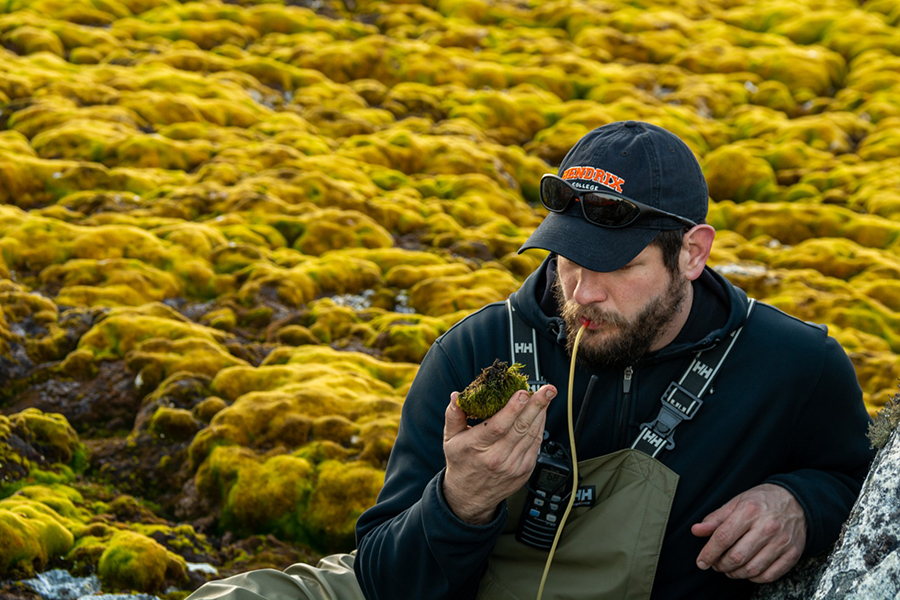Insects in the ExtremeWhat the Genes of Antarctica's Tough Little Midge Can Tell UsPosted June 29, 2020
Scientists are taking a close look at Antarctica's largest land animal. It's a small insect called the Antarctic midge, and they don't grow much bigger than a fingernail. There are a lot of persistent questions about these critters, and researchers are hoping that a broad study of their tiny genome can start to reveal some answers. Over February and March, a team of scientists sailed on the research vessel Laurence M. Gould down the Antarctic Peninsula coast, conducting the widest-ranging study of the Antarctic midge yet. 
Photo Credit: Mike Lucibella
Scott Hotaling carefully places a midge larvae in a sample vial. The team plans to use these midges to create a genetic map of their spread across the Antarctica Peninsula.
"We were able to collect midges that live in different places and experience different environments," said Nicholas Teets of the University of Kentucky and principal investigator on the project. "We're going to look at their underlying genetic makeup to see how their genetic makeup differs across these different parts of Antarctica." By comparing their genetic maps, they hope to learn more about how these insects have persisted on the harshest continent for millions of years, and what the future might hold for them. "We're interested in how these populations got to be where they are throughout the history of Antarctica," Teets said. The project is supported by the National Science Foundation, which manages the U.S. Antarctic Program. No Ants in AntarcticaThough insects are ubiquitous around the world, they're somewhat of an aberration in Antarctica. "Insects are incredibly rare in Antarctica. There have been a million insect species found on Planet Earth and only three insects can be found in Antarctica, so it's a really hard place for insects to live," Teets said. "We're interested in how they can do that, what are the special unique adaptations they have that allow them to cope with these extreme Antarctic environments." Of those three species, only Belgica antarctica, more commonly known as the Antarctic midge, is truly a native of the frozen continent. They're pretty hardy critters, and have to be in order to live and thrive on the harshest continent. "They're what we consider a poly-extremophile, meaning that they're highly tolerant of a lot of different kinds of stress," Teets said. They live and thrive in extremely cold and dry conditions, environments that most living things would find downright lethal. "The Antarctic midge places a bound on a lot of those things," said Scott Hotaling, a post-doctoral researcher at Washington State University. "It is the most southern living insect in the world. It is one of the most cold-tolerant. It is one of the most desiccation-tolerant. It has the smallest genome, and it is the only insect that is endemic to Antarctica." The researchers are themselves working to understand the bounds of what kind of extreme conditions midges can tolerate, and how it goes about doing that. "Our work has started as basic physiological tolerances; how are they surviving here and what are they able to tolerate," said J.D. Gantz, a physiologist at Hendrix College. "[That] has evolved into asking questions about how well this insect disperses, how well is it able to get from one place to another and how that affects gene flow among populations and also how that matches up with physiological tolerances in this animal from population to population." 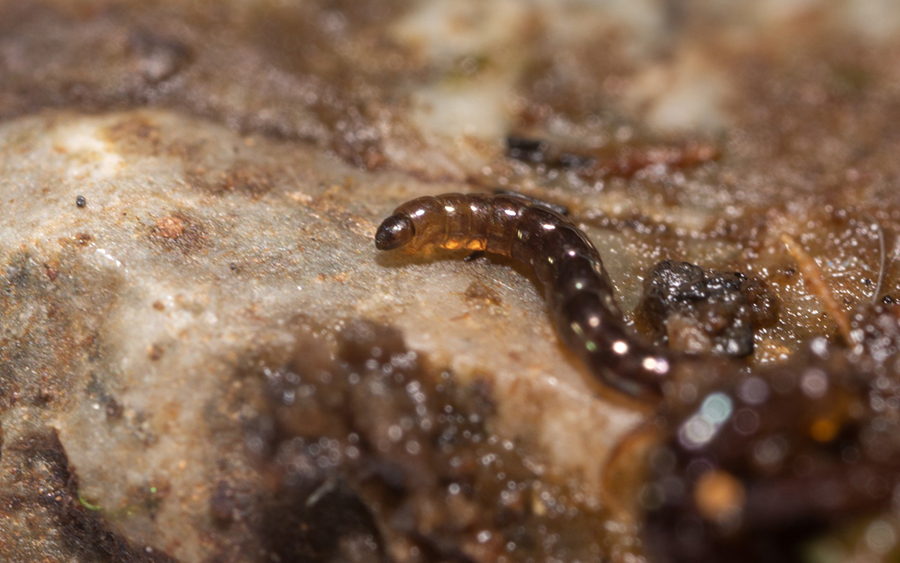
Photo Credit: Mike Lucibella
The larvae of Belgica antarctica, more commonly known as the Antarctic midge, are less than a centimeter long, and live in the Antarctic soil and moss for two years before becoming an adult.
These insects have evolved ways to somehow cope with Antarctica's subzero temperatures. One of the hopes is that by learning how these midges have adapted to freezing solid for more than half of the year, researchers can transfer some of those techniques for other purposes. "My lab is also interested in cryopreservation, or the ability to store things in the cold for a long time," Teets said. "Part of our goal for studying adaptations in species like the Antarctic midge, that are already really good at freezing, is to see if some of that information could be applied to helping freeze other things, and maybe even further into the future, insights from species like the midge could be used to improve cryopreservation of human tissues and organs." Fridges of MidgesTo study the Antarctic midge, the team first had to go out and find some. The field team sailed on the research vessel Laurence M. Gould down the Antarctic Peninsula coast, stopping at more than 20 sites along the way to collect and store living samples. "This season was primarily focused on getting the samples for the population genetics," Teets said. "[The field team members] were on the ship and they had access to all these different collecting sites that we've never been to before." At each field site, the team would take a small boat to shore and fan out, looking for tell-tale tufts of plant or algae growth that usually meant midges would be found below. The midge larvae are themselves smaller than a grain of rice, but often gather together in clumps. Gingerly, with tweezers or a suction aspirator, they set about collecting several dozen midge larvae from each site. "It's particularly useful to get so many because we're unable to breed them in the lab currently," said Jacob Idec, a post-undergraduate student at Hendrix College. "Where we get them essentially is collecting." After collecting what they needed from one locale, they would look around for a different microenvironment, usually somewhere higher up, farther away from shore or generally drier. 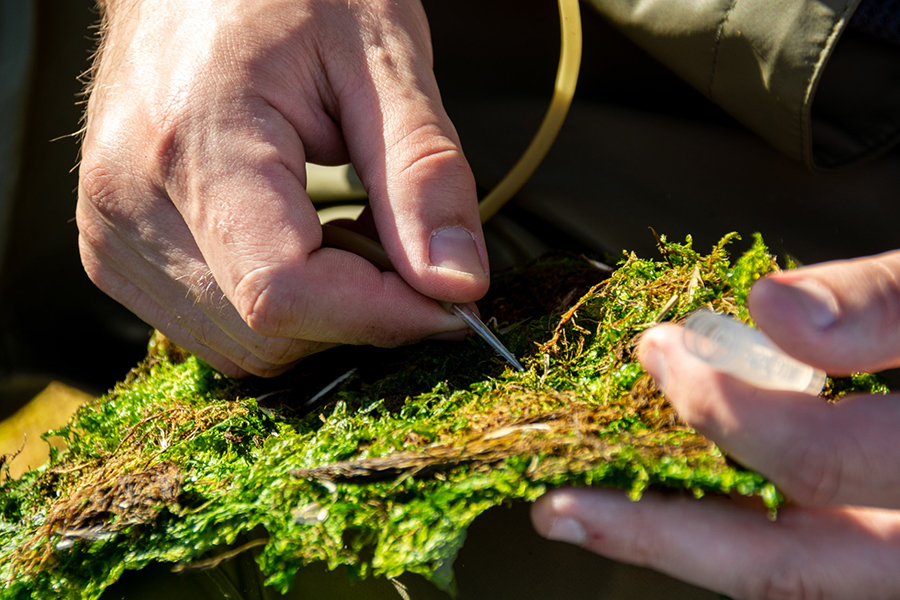
Photo Credit: Mike Lucibella
J.D. Gantz uses his suction aspirator to carefully remove a midge larvae from a clot of moss.
"We got a whole lot of sites and a whole lot of midges," Idec said. "We've had a lot of good days and we've been able to collect a lot of midges in a lot of different places, which has been exciting, and basically should make the genetics that come out of this more valuable, having more sites and more locations." By comparing midges across varied environments and different locations along the peninsula, the team hopes to see what kinds of genetic differences exist between populations and glean some insight into how they adapted to their particular niche on the continent. "We're collecting really fine-scale genomic data from lots of individuals from each population so will get a good perspective on total genetic diversity within the population and we'll be able to take those data and compare it among populations," Hotaling said. "Is there a pattern of basically the further apart you are, the more genetically distinct you are? Or, because we're sampling things like a higher elevation hilltop versus a little valley, or a place where there's a lot of penguin guano versus not, does genetic differentiation structure by habitat type? So these two traditionally in the genetic literature are called isolation by distance, you're further apart so you're more different, versus isolation by environment, where it's not distance, it's how similar your environment is." This question of which populations are the most similar to each other is of particular interest because though midges are adept at it, thriving in Antarctica is not a particularly glamourous lifestyle. They spend the vast majority of their two-year lives as barely-mobile larvae. Resembling tiny dark worms, they crawl around just under the surface, usually in patches of moss or terrestrial algae or even penguin guano. For about eight months of the year, the larvae are actually frozen, only thawing out to feed during the warmest summer months. 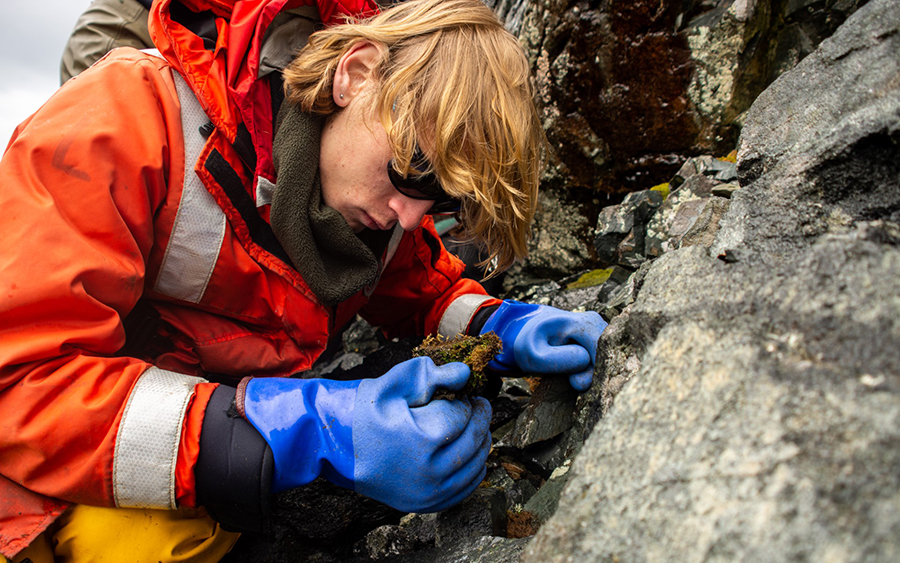
Photo Credit: Mike Lucibella
Jacob Idec takes a close look at a clot of moss for any midges that might be living in it.
"They only spend about ten to 14 days as adults," Teets said. "When they're adults they're wingless. They also don't have any functional mouth parts as an adult, they don't eat or drink anything, they just crawl around, look for a mate, the females lay their eggs and then they die." This largely soil-dwelling lifecycle, combined with their winglessness, presents a puzzle to researchers trying to figure out how they've been able to spread so widely down the length of the Antarctic Peninsula. "There's no clear mechanism for this insect to move around, to disperse from place to place," Gantz said. "The adults are the dispersal phase [but] they live just a few days. They are wingless, they do not ride on air currents, at least I should say we've never seen them riding on air currents, and we have looked for it. They don't float especially well. We're just not really sure how this insect would be getting from island to island." Though the team doesn't expect to solve all of these mysteries with their genetic data alone, by knowing which populations are most similar they can start to get an idea of just how mobile the midges as a species are. There are other lingering questions about them that the team hopes to glean some insight into. 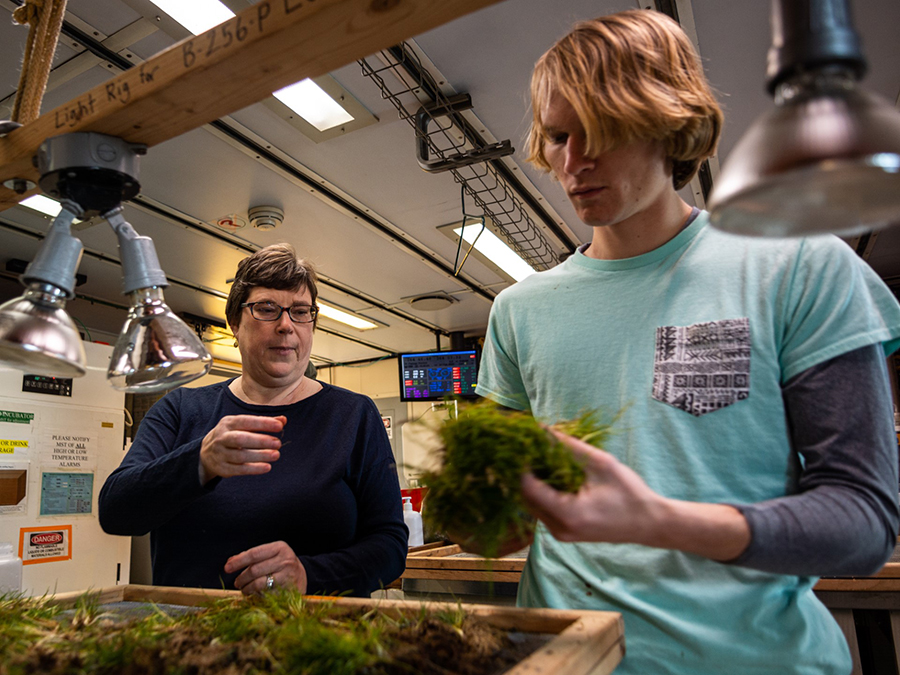
Photo Credit: Mike Lucibella
Onboard the research vessel Laurence M. Gould, Debbie Harner (left) helps Jason Idec sort through collected moss samples to try and extract any larvae from them.
Tough BugsThe midge's closest relative hails from the Patagonia region of South America, which Antarctica broke away from some 30 to 40 million years ago with the opening of the Drake Passage. Over that time, the globe has undergone a number of ice ages; eras where the Antarctic ice caps grew even larger, engulfing the midge's few ice-free areas of refuge. How the species was able to survive through extended deep freezes for hundreds of thousands of years is another mystery. "They've somehow been able to persist in Antarctica throughout these repeated glaciation cycles," Teets said. "Some of this genetic data will help us answer some of those questions about how they got to be where they are." Though the midges have managed to survive some intensely frigid times on the continent, the future is looking warmer, and that could spell trouble for the insects. "One of the very few stresses that they don't handle well is high temperature," Gantz said. "At least from a theoretical standpoint, climate change is not going to be a good thing, especially if, as we suspect, they're not very good at dispersing, so they don't have a clear mechanism to move south as things warm up further north." Plus, as the peninsula warms, insects from the warmer north could start making their way into the Antarctic midge's territory and start pushing them out. 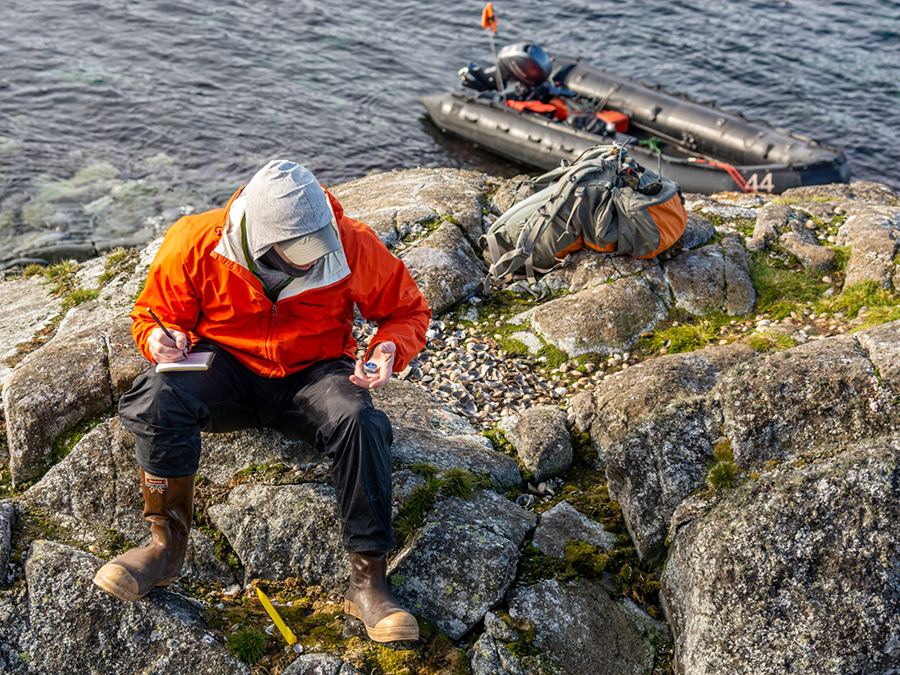
Photo Credit: Mike Lucibella
Scott Hotaling prepares to lay out a data logger on an island near Palmer Station. The loggers gather data about temperature and moisture conditions under the soil over the course of a year.
"Our first site of this trip was Byers Peninsula on Livingston Island. We found a different midge there which looks a lot like Belgica, but has wings on the adults," Hotaling said. "It's pretty easy to imagine that if that species' lower latitudinal limits is being set by low temperatures, which are rising, it could actively disperse south, and potentially displace Belgica." Some of the physiological studies the team has planned for the midges they collected could offer insight into how well the Antarctic midge will respond to changing climatic conditions. However, it's particularly hard to know for sure what's likely to happen when there are still many basic unanswered questions about Antarctic midges. "We barely know where the limits of their population are, we have not even anything close to a population size estimate, we don't know if they're increasing or if they're declining," Gantz said. Because of the remoteness of where these midges call home, it may be years, or even decades before scientists can start to get a real handle on some of these questions. Debbie Harner, an educator at the Living Arts and Science Center in Lexington, Kentucky, joined the field team to help share their work with the public and inspire the next generation of scientists who might take up that charge. 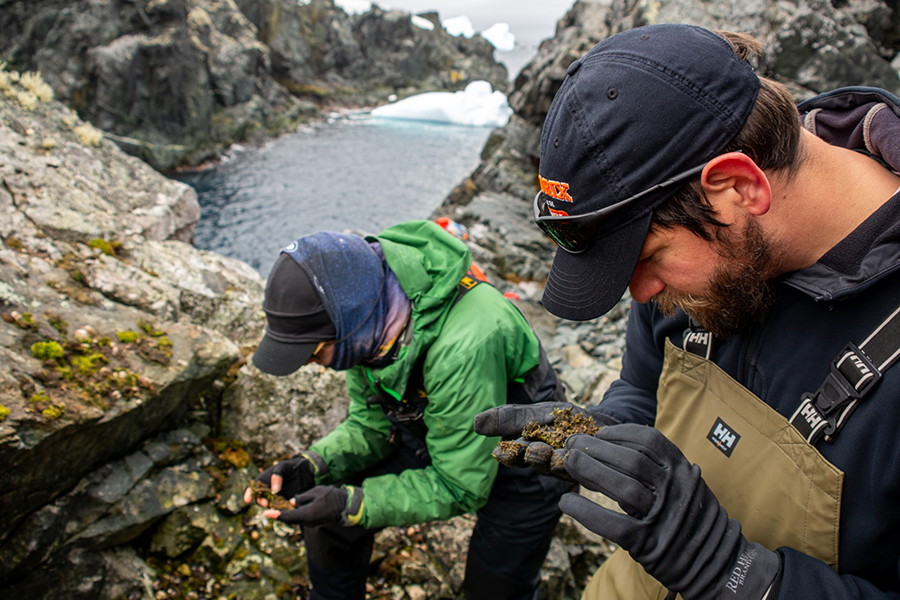
Photo Credit: Mike Lucibella
Laboratory technician Diane Hutt (left) helps J.D. Gantz look for midges one of the Melchior islands along the Antarctic Peninsula.
"I have the opportunity to share with young kids what they're doing," Harner said. "I'll be taking an Antarctic program out to the community, sharing what we've done on this journey and teaching kids about Antarctic animals like the midge and some of the adaptations that they have." Right now, the hundreds of larvae the team collected are split between Teets's lab in Kentucky and Gantz's lab in Arkansas, as the team prepares to start their genetic and physiological work. The team has two more seasons of fieldwork planned and intend to return to several of their best sites to collect more samples. NSF-funded research in this story: Nicholas Teets, University of Kentucky, Award No. 1850988. |



For USAP Participants |
For The Public |
For Researchers and EducatorsContact UsU.S. National Science FoundationOffice of Polar Programs Geosciences Directorate 2415 Eisenhower Avenue, Suite W7100 Alexandria, VA 22314 Sign up for the NSF Office of Polar Programs newsletter and events. Feedback Form |


